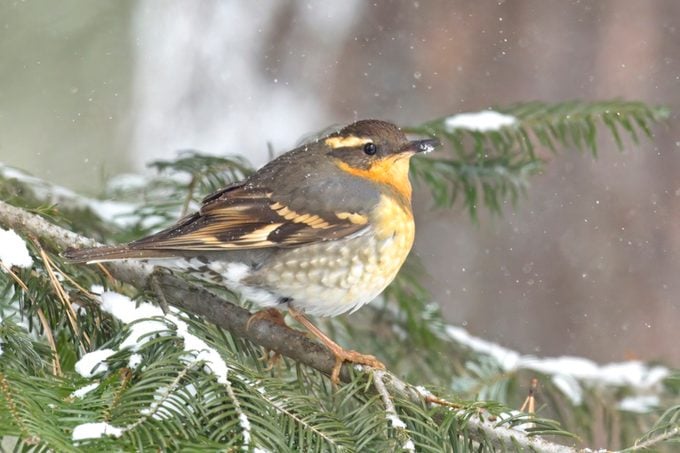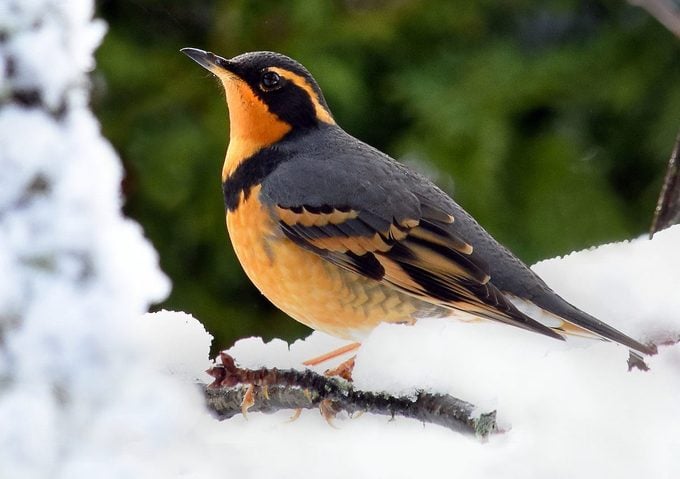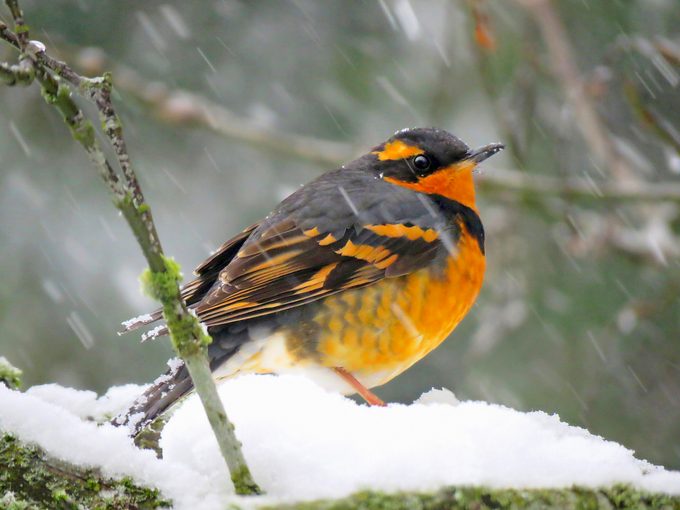Meet the Varied Thrush: Voice of the Northwest
Updated: Jul. 10, 2024
Learn everything you need to know about the colorful varied thrush, a bird known for its dramatic beauty and haunting call.
Here’s how to identify the remarkable varied thrush and how to attract these beautiful birds to your yard.
On This Page
What Does a Varied Thrush Look Like?

About the size and shape of the American robin, the varied thrush sports a bold black band that resembles a necklace on its rich orange breast that contrasts with a blue-gray back, orange wing bars and a wide black stripe across its eye. The females look similar but paler.
Learn how to identify the rest of the birds in the thrush family.
Seeing this species is a treat, since varied thrushes are “not the kind of bird to sit out in the open,” says Maeve Sowles, president of the Lane County Audubon Society in Oregon. “You hear them more than you see them.”
Varied Thrush vs American Robin

It may be difficult to tell female or juvenile varied thrush apart from robins since they share similar coloring and size. You’ll know it’s a varied thrush if there are stripes on the chest and wings.
See more types of birds that look like robins
Varied Thrush Range and Habitat

These particular thrushes live year-round in the wet forests of the mild Pacific Coast—all the way from southeastern Alaska to Northern California. Farther inland and north they are migratory, nesting in forests from Alaska to the mountains of Montana. They retreat southward and to lower elevations in autumn, when they often visit backyards and city parks.
This species is known for being a notorious wanderer outside of breeding season. It’s been sighted in every state of the Lower 48, often foraging in the midst of a flock of robins. Look closely and you, too, may spot this beauty.
Learn how to identify a wood thrush.
Varied Thrush Bird Song and Call
Bird songs courtesy of the Cornell Lab of Ornithology
Just like the first robin of spring, “the first report of a varied thrush in fall gets a lot of excitement!” Maeve says. She recommends opening a window on an autumn morning and listening for a very haunting yet distinct call.
The varied thrush sings a single drawn-out note, then pauses, then another note comes, and so on. “Each note grows out of nothing, swells to a full tone, and then fades away to nothing until one is carried away with the mysterious song,” ornithologist and bird artist Louis Agassiz Fuertes said in a handbook more than a hundred years ago.
Hear the sounds of the American robin bird call.
What Do Varied Thrushes Eat?

Look for these ground feeders under trees and shrubs. They often scratching aggressively in leaf litter for beetles, sowbugs, snails, worms and other morsels. “In fall and winter, they eat fruit and berries from trees and bushes,” Maeve says. “This includes crabapples, native salal, thimbleberry, cascara, snowberry and others—well, for as long as they last.”
To attract varied thrushes to your yard, scatter birdseed mix on the ground and offer suet in a wire cage. Try one of our homemade suet recipes for birds. “Varied thrushes stay all winter,” Maeve says, “even in snow and ice storms. We don’t have cardinals, but a varied thrush in snow is just as impressive!”
Next, discover how American robins find worms.
About the Expert
Lifelong outdoor enthusiast Maeve Sowles has been president of the Lane County Audubon Society in Oregon since 2000.






















